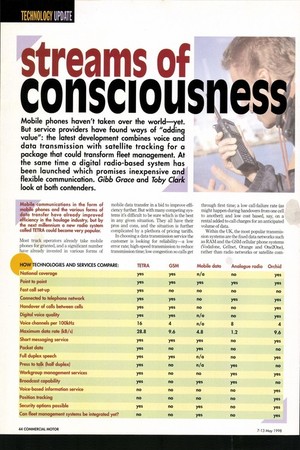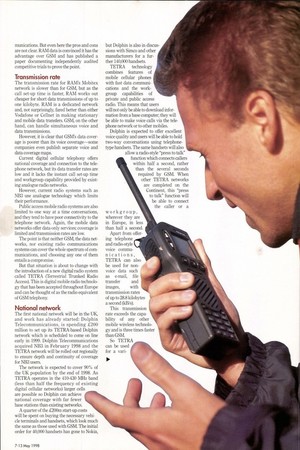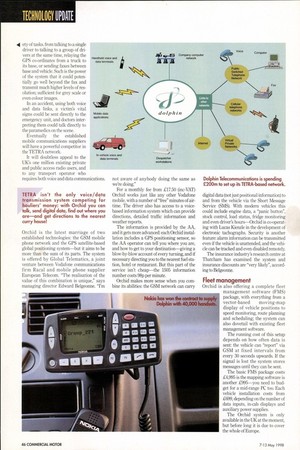streams of consciousnes Mobile phones haven't taken over the world—yet.
Page 44

Page 45

Page 46

If you've noticed an error in this article please click here to report it so we can fix it.
But service providers have found ways of "adding value": the latest development combines voice and data transmission with satellite tracking for a package that could transform fleet management. At the same time a digital radio-based system has been launched which promises inexpensive and flexible communication. Gibb Grace and Toby Clark look at both contenders. J i Mobile communications in the form of mobile phones and the various forms of data transfer have already improved efficiency in the haulage industry, but by the next millennium a new radio system called TETRA could become very popular.
Most truck operators already take mobile phones for granted, and a significant number have already invested in various forms of mobile data transfer in a bid to improve efficiency further. But with many competing systems it's difficult to be sure which is the best in any given situation. They all have their pros and cons, and the situation is further complicated by a plethora of pricing tariffs.
In choosing a data transmission service the customer is looking for reliability—a low error rate; high-speed transmission to reduce transmission time; low congestion so calls get through first time; a low call-failure rate (as might happen during handovers from one cell to another); and low cost based, say, on a rental added to call charges for an anticipated volume of data.
Within the UK, the most popular transmission systems are the fixed data networks such as RAM and the GSM cellular phone systems (Vodafone, Cellnet, Orange and One2One), rather than radio networks or satellite com munications. But even here the pros and cons are not clear. RAM data is convinced it has the advantage over GSM and has published a paper documenting independently audited competitive trials to prove the point.
Transmission rate The transmission rate for RAM's Mobitex network is slower than for GSM, but as the call set-up time is faster, RAM works out cheaper for short data transmissions of up to one kilobyte. RAM is a dedicated network and, not surprisingly, fared better than either Vodafone or Cellnet in making stationary and mobile data transfers. GSM, on the other hand, can handle simultaneous voice and data transmissions.
However, it is clear that GSM's data cover age is poorer than its voice coverage some companies even publish separate voice and data coverage maps.
Current digital cellular telephony offers national coverage and connection to the telephone network, but its data transfer rates are low and it lacks the instant call set-up time and workgroup capability provided by existing analogue radio networks.
However, current radio systems such as NB3 use analogue technology which limits their performance.
Public access mobile radio systems are also limited to one way at a time conversations, and they tend to have poor connectivity to the telephone network. Again, the mobile data networks offer data-only services; coverage is limited and transmission rates are low.
The point is that neither GSM, the data networks, nor existing radio communications systems can cover the whole spectrum of communications, and choosing any one of them entails a compromise.
But that situation is about to change with the introduction of a new digital radio system called TETRA (Terrestrial Trunked Radio Access). This is digital mobile radio technology that has been accepted throughout Europe and can be thought of as the radio equivalent of GSM telephony.
National network The first national network will be in the UK, and work has already started: Dolphin Telecommunications, is spending £200 million to set up its TETRA-based Dolphin network which is scheduled to come on line early in 1999. Dolphin Telecommunications acquired NB3 in February 1998 and the TETRA network will be rolled out regionally to ensure depth and continuity of coverage for NB3 users.
The network is expected to cover 90% of the UK population by the end of 1998. As TETRA operates in the 410-430 MHz band (less than half the frequency of existing digital cellular networks) larger cells are possible so Dolphin can achieve national coverage with far fewer base stations than existing networks.
A quarter of the £200m start-up costs will be spent on buying the necessary vehicle terminals and handsets, which look much the same as those used with GSM. The initial order for 40,000 handsets has gone to Nokia, but Dolphin is also in discussions with Simco and other manufacturers for a further 140,000 handsets.
TETRA technology combines features of mobile cellular phones with fast data communications and the workgroup capabilities of private and public access radio. This means that users will not only be able to download information from a base computer; they will be able to make voice calls via the telephone network or to other mobiles.
Dolphin is expected to offer excellent voice quality and users will be able to hold two-way conversations using telephonetype handsets. The same handsets will also allow a radio-style "press to talk" function which connects callers within half a second, rather than the several seconds required by GSM. When other TETRA networks are completed on the Continent, this "press to talk" function will be able to connect the caller or a transfer and images, with transmission rates of up to 28.8 kilobytes a second (kB/s).
So TETRA can be used for a van 4 ety of tasks, from talking to a single driver to talking to a group of drivers at the same time, relaying the GPS co-ordinates from a truck to its base, or sending faxes between base and vehicle. Such is the power of the system that it could potentially go well beyond the fax and transmit much higher levels of resolution; sufficient for grey scale or even colour images.
In an accident, using both voice and data links, a victim's vital signs could be sent directly to the emergency unit, and doctors interpreting them could talk directly to the paramedics on the scene.
Eventually the established mobile communications suppliers will have a powerful competitor in the TETRA network.
It will doubtless appeal to the UK's one million existing private and public access radio users, and to any transport operator who requires both voice and data communications.
TETRA isn't the only voice/data transmission system competing for hauliers' money: with Orchid you can talk, send digital data, find out where you are—and get directions to the nearest curry house!
Orchid is the latest marriage of two established technologies: the GSM mobile phone network and the GPS satellite-based global positioning system—but it aims to be more than the sum of its parts. The system is offered by Global Telematics, a joint venture between Vodafone communications firm Racal and mobile phone supplier European Telecom. "The realisation of the value of this combination is unique," says managing director Edward Belgeonne. "I'm not aware of anybody doing the same as we're doing."
For a monthly fee from £17.50 (inc-VAT) Orchid works just like any other Vodafone mobile, with a number of "free" minutes of airtime. The driver also has access to a voicebased information system which can provide directions, detailed traffic information and weather reports.
The information is provided by the AA, and it gets more advanced: each Orchid installation includes a GPS positioning sensor, so the AA operator can tell you where you are, and how to get to your destination—giving a blow-by-blow account of every turning, and if necessary directing you to the nearest fuel station, hotel or restaurant. But this part of the service isn't cheap—the 1505 information number costs 98p per minute.
Orchid makes more sense when you combine its abilities: the GSM network can carry digital data (not just positional information) to and from the vehicle via the Short Message Service (SMS). With modern vehicles this could include engine data, a "panic button", stock control, load status, fridge monitoring and even driver's hours Orchid is co-operating with Lucas Kienzle in the development of electronic tachographs. Security is another feature: alarm information can be transmitted even if the vehicle is unattended, and the vehicle can be tracked and even disabled remotely.
The insurance industry's research centre at Thatcham has examined the system and insurance discounts are "very likely", according to Belgeonne.
Fleet management Orchid is also offering a complete fleet management software (FMS) package, with everything from a vector-based moving-map display of vehicle positions to speed monitoring, route planning and scheduling; the system can also dovetail with existing fleet management software.
The running cost of this setup depends on how often data is sent: the vehicle can "report" via GSM at fixed intervals from every 30 seconds upwards. If the signal is lost the system stores messages until they can be sent.
The basic FMS package costs £4,995 is the mapping software is another L995—you need to budget for a mid-range PC too. Each vehicle installation costs from £699, depending on the number of data inputs, in-cab displays and auxiliary power supplies.
The Orchid system is only available in the UK at the Moment, but before long it is due to cover the whole of Europe.
























































































































